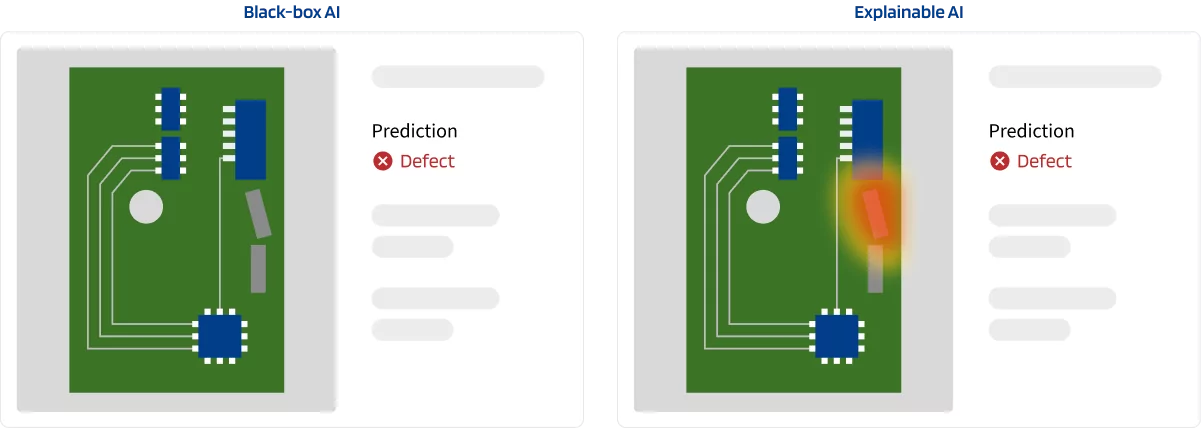
Blog
Augmented Intelligence: How explainable AI is changing manufacturing jobs for the better
This is a shortened reproduction of the article “Augmented intelligence: How explainable AI is changing manufacturing jobs for the better,” which we recently published in the World Economic Forum’s Agenda.
The end of human work?
A common narrative suggests AI is poised to replace human work on a large scale. Our research in diverse manufacturing settings rejects that vision. Instead, AI holds the potential to augment human intelligence to solve work tasks more effectively while also enriching the work experience. The key to unlocking this potential lies in explainable algorithms, which contrast the often-opaque decision-making processes in conventional AI systems.
Despite its promise, the adoption of AI in the workplace has been slower than one might expect, and this reluctance has been partially driven by two critical factors. The first is “algorithm aversion,” a reluctance among humans to trust AI systems that operate as “black boxes,” providing decisions without any clear rationale. The second challenge is that the opaque nature of many state-of-the-art algorithms prevents domain experts from benchmarking AI-generated recommendations against domain knowledge, making it difficult to identify and rectify errors. These issues not only erode trust in AI but also limit the scope for effective human-AI collaboration.
This is where explainable AI (XAI) offers a significant breakthrough. Our multi-year research journey in the manufacturing sector leads us to a unifying conclusion: explainability is the missing ingredient that catalyzes AI adoption in manufacturing. Why? Explainable AI works as an interpreter that bridges the gap between complex algorithmic processes and human understanding. Much like how an interpreter can make complex information accessible to a layperson, XAI demystifies the intricate logic of complex algorithms.
By transforming the AI’s ‘black box’ into recommendations with clear explanations, XAI fosters greater trust and enables more effective human-AI collaboration. Not only is XAI making AI more ethical and accountable, but our research shows that it also improves work experience and job performance. While AI has the capacity to sift through massive datasets and identify patterns far beyond human capability, it is the symbiosis of human expertise and AI recommendations that truly unlocks productivity gains.
Experts with XAI outperform AI
A compelling case study that elucidates the importance of XAI comes from our work with Siemens. We conducted an experiment where we compared the performance of two groups of factory workers in a visual quality inspection task of electronic products. The first group was assisted by conventional ‘black-box’ AI, while the second had the benefit of an AI that provided visual heatmaps to explain its predictions of potential quality issues.

The results were striking: expert workers without explanations were more than three times more likely to erroneously override the accurate recommendations given by the AI. In contrast, those augmented by XAI knew better when to trust the AI and when to depend on their own expertise, thereby outperforming the performance of the AI system alone. This shows that XAI is not just about smarter machine decisions; it’s a transformative approach that enables both humans and machines to perform at their best.
XAI is not just beneficial for providing decision support to operators on the shopfloor; it can also help understand complex production systems, providing critical insights to manufacturing experts. During our collaboration with a semiconductor factory, we equipped process experts with XAI tools to elucidate the root causes of quality issues. While the AI explained complex associations between production variables and quality outcomes, it took human expertise to turn these insights into effective improvement actions.
By cross-referencing the AI’s explanations with their own domain knowledge, experts were able to design targeted experiments to confirm the underlying causes of quality losses. The result? Quality losses plummeted by over 50%, a testament to the efficacy of human-machine collaboration with AI-based explanations.
A compelling case for augmented intelligence
Our research strongly suggests that the future of manufacturing is not a battle of humans versus machines but rather a collaborative enterprise that leverages the unique strengths of both. Many work tasks will not and cannot be replaced or delegated to an AI.
However, AI can augment human work and create more effective and efficient tasks – especially when the AI’s decisions are explained. We thus call for a paradigm shift: rather than “replacing” humans with AI, it will be necessary to “augment” humans. This requires a completely different set of tools, and we deem one particularly relevant: XAI.
